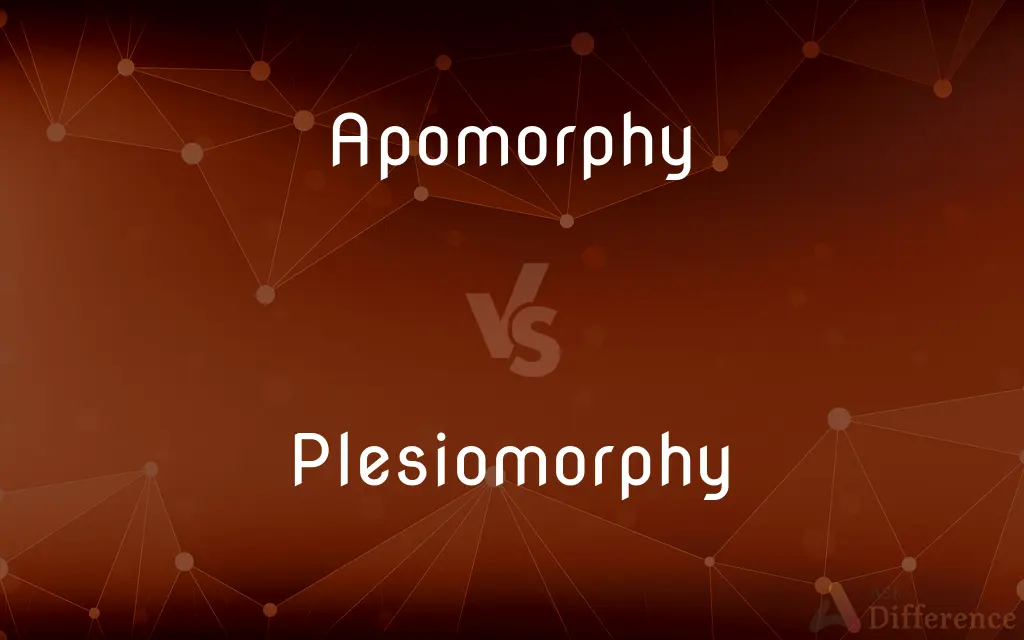Apomorphy vs. Plesiomorphy — What's the Difference?
Edited by Tayyaba Rehman — By Urooj Arif — Updated on March 20, 2024
Apomorphy refers to a derived or new trait specific to a particular group or lineage, indicating evolutionary divergence. Plesiomorphy represents an ancestral trait shared by multiple groups, reflecting their common evolutionary background.

Difference Between Apomorphy and Plesiomorphy
Table of Contents
ADVERTISEMENT
Key Differences
Apomorphy is a term used in phylogenetics to describe a trait or characteristic that is newly evolved in a particular lineage and serves as a distinguishing feature of that group. This type of trait is indicative of evolutionary change and helps in identifying more recent evolutionary relationships. On the other hand, plesiomorphy pertains to an ancestral trait that is shared by multiple lineages or groups, pointing to a common evolutionary origin. These traits are older and are used to identify broader relationships among different groups.
An apomorphic feature can be something as specific as the presence of feathers in birds, setting them apart from other vertebrates and indicating their unique evolutionary path. Conversely, a plesiomorphic trait might be the presence of vertebrae, which is shared by a wide range of animals, including birds, mammals, and reptiles, showcasing their common ancestry.
In cladistics, which is a method of classifying organisms based on common ancestry, apomorphies are critical for defining clades or monophyletic groups. These groups consist of a species and all its descendants, all of which share the apomorphic traits. In contrast, plesiomorphies are not useful for defining such groups because they are shared by more distant relatives, reflecting a deeper evolutionary lineage that encompasses a broader range of organisms.
The identification of apomorphic traits is essential for constructing phylogenetic trees, which are diagrams that represent the evolutionary relationships among various biological species. These trees are based on shared derived characteristics (apomorphies) rather than on primitive or ancestral characteristics (plesiomorphies), allowing for a more accurate depiction of evolutionary lineage.
While apomorphy highlights evolutionary innovation and divergence, plesiomorphy emphasizes the evolutionary heritage and similarities among different groups. Understanding the distinction between these terms is crucial for interpreting evolutionary relationships and reconstructing the evolutionary history of life on Earth.
ADVERTISEMENT
Comparison Chart
Definition
A derived or new trait specific to a lineage
An ancestral trait shared by multiple groups
Significance
Indicates evolutionary divergence and innovation
Reflects common evolutionary background
Usage in Phylogeny
Useful for defining and identifying specific clades
Indicates broader, more inclusive evolutionary relationships
Example
Feathers in birds
Vertebrae in vertebrates
Evolutionary Implication
Marks a point of divergence within a lineage
Points to a deeper, common ancestry
Compare with Definitions
Apomorphy
An apomorphy is a newly evolved trait unique to a particular group.
The presence of a marsupial pouch in kangaroos is an apomorphy distinguishing them from other mammals.
Plesiomorphy
A plesiomorphy is an ancestral trait shared across multiple lineages.
The backbone is a plesiomorphy shared by all vertebrates.
Apomorphy
Apomorphies are used to identify more recently evolved lineages.
Flowering in angiosperms is an apomorphy that separates them from other plant groups.
Plesiomorphy
It reflects the evolutionary history and common origin of diverse groups.
Photosynthesis is a plesiomorphy among plants and algae.
Apomorphy
It signifies evolutionary innovation and specialization.
The development of opposable thumbs is an apomorphy in primates.
Plesiomorphy
Plesiomorphic traits can be overshadowed by more recent evolutionary changes.
Gills are a plesiomorphy in aquatic animals, though some have evolved to breathe air.
Apomorphy
They are crucial for constructing detailed phylogenetic trees.
The bipedal stance is an apomorphy that helps define the human lineage within primates.
Plesiomorphy
Plesiomorphies are foundational traits from which new characteristics evolve.
Having four limbs is a plesiomorphy for tetrapods.
Apomorphy
Apomorphies can arise in any characteristic, from physical features to genetic sequences.
The specific gene mutation for blue eyes is considered an apomorphy in humans.
Plesiomorphy
They are less useful for defining specific evolutionary branches.
The presence of DNA as genetic material is a plesiomorphy for all life forms.
Apomorphy
An apomorphous character.
Plesiomorphy
The state of being plesiomorphic; ancestral or primitive condition as compared to a later, derived character state. Also (as a count noun): an ancestral or plesiomorphic feature or trait.
Apomorphy
An evolved character or trait unique to a particular phylogenetic group of organisms. The vertebral column is an apomorphy of vertebrates.
Plesiomorphy
An evolved character or trait that is shared by some or all members of a phylogenetic group and their common ancestor but is not unique to that group. A segmented spinal column is a plesiomorphy of mammals, being present as well in other groups such as fishes, reptiles, amphibians, and birds.
Apomorphy
(systematics) A derived characteristic of a clade. Any feature novel to a species and its descendants.
Plesiomorphy
(cladistics) A character state that is present in both outgroups and in the ancestors
Common Curiosities
How are apomorphies identified in evolutionary studies?
Apomorphies are identified by comparing the traits of closely related organisms and determining which traits are unique to certain lineages.
Can behavioral traits be considered apomorphies or plesiomorphies?
Yes, behavioral traits can also be classified as apomorphies or plesiomorphies if they signify evolutionary changes or ancestral states, respectively.
What is the key difference between an apomorphy and a plesiomorphy?
The key difference lies in their evolutionary significance: apomorphy indicates a newly evolved, lineage-specific trait, while plesiomorphy refers to an older, ancestral trait shared by multiple groups.
How do environmental changes impact the development of apomorphies?
Environmental changes can drive evolutionary adaptations, leading to the development of apomorphies as organisms evolve new traits to better survive and reproduce in their changing habitats.
Can the same apomorphy evolve independently in different lineages?
Yes, the same apomorphy can evolve independently in different lineages through a process called convergent evolution, where similar environmental pressures lead to similar adaptations.
Why are apomorphies more useful than plesiomorphies in phylogenetic analysis?
Apomorphies are more useful because they help identify specific evolutionary branches and relationships, whereas plesiomorphies are too general to provide detailed insights.
Can a trait be both an apomorphy and a plesiomorphy?
A trait can be an apomorphy at one level of analysis (among a smaller, more closely related group) and a plesiomorphy at another level (when considering a broader group of related organisms).
How does the concept of synapomorphy relate to apomorphy?
A synapomorphy is a type of apomorphy that is shared by two or more groups, indicating a common evolutionary origin, and is crucial for defining clades in phylogenetics.
Are molecular traits considered when identifying apomorphies and plesiomorphies?
Yes, molecular traits, such as DNA sequences, can be analyzed to identify apomorphies and plesiomorphies, providing insights into evolutionary relationships at the genetic level.
Can an apomorphy be lost in a lineage over time?
Yes, an apomorphy can be lost due to further evolutionary changes, but its previous presence can still provide important information about historical evolutionary paths.
Why are plesiomorphies important for understanding the early stages of evolutionary history?
Plesiomorphies provide insights into the early stages of evolutionary history by highlighting the foundational traits from which more specialized and diverse traits evolved.
Is it possible for a plesiomorphy to become an apomorphy?
An ancestral trait (plesiomorphy) itself does not become an apomorphy, but it can give rise to new, derived traits (apomorphies) in different lineages.
How do scientists distinguish between apomorphies and plesiomorphies in fossil records?
Scientists use comparative anatomy, phylogenetic analysis, and sometimes molecular data from closely related living species to infer the evolutionary status of traits observed in fossils.
What role does genetic analysis play in identifying apomorphies and plesiomorphies?
Genetic analysis plays a crucial role by providing molecular evidence for the evolutionary relationships among species, helping to distinguish between derived traits (apomorphies) and ancestral traits (plesiomorphies).
Share Your Discovery

Previous Comparison
SASS vs. LESS
Next Comparison
Marking vs. RosetteAuthor Spotlight
Written by
Urooj ArifUrooj is a skilled content writer at Ask Difference, known for her exceptional ability to simplify complex topics into engaging and informative content. With a passion for research and a flair for clear, concise writing, she consistently delivers articles that resonate with our diverse audience.
Edited by
Tayyaba RehmanTayyaba Rehman is a distinguished writer, currently serving as a primary contributor to askdifference.com. As a researcher in semantics and etymology, Tayyaba's passion for the complexity of languages and their distinctions has found a perfect home on the platform. Tayyaba delves into the intricacies of language, distinguishing between commonly confused words and phrases, thereby providing clarity for readers worldwide.














































